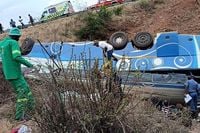On the evening of October 12, 2025, tragedy struck in South Africa’s Limpopo province as a long-distance passenger bus veered off the N1 highway near the town of Louis Trichardt—also known as Makhado—tumbling down a steep mountain embankment and landing upside down. The devastating crash claimed at least 42 lives, including seven children and a 10-month-old baby, and left 49 others injured, according to the South African Department of Transport and Community Safety (as reported by the Associated Press and Sky News).
The accident unfolded around 6 p.m., on one of South Africa’s busiest cross-border routes, about 250 miles north of the capital, Pretoria, and just 55 miles from the Zimbabwe border. The bus, operated by DNC Coaches, was making its way from Gqeberha (formerly Port Elizabeth) in the Eastern Cape, bound for Zimbabwe and Malawi. Most passengers were Zimbabwean and Malawian nationals, many of them migrant workers journeying home with their families, according to transportation officials cited by UPI and New York Times.
Emergency crews rushed to the scene, finding the blue bus overturned in the embankment, its roof crushed and debris scattered. Rescuers worked late into the night, braving darkness and treacherous terrain to pull victims from the wreckage and transport survivors to area hospitals. The Limpopo provincial government reported that six people were critically injured, while another 31 suffered serious injuries. One critically injured child was airlifted to a hospital for urgent care. Authorities feared that some passengers might still be trapped inside the mangled vehicle as the rescue operation continued into the early hours of October 13, 2025 (Al Jazeera).
The human toll was staggering. The Transport Ministry confirmed the victims included 18 women, 17 men, and seven children. Limpopo Premier Phophi Ramathuba, who visited the crash site and later met with survivors in hospital, expressed the region’s grief, stating, “Losing so many lives in one incident is painful beyond words.” The provincial government has since mobilized counseling services for the bereaved and is working closely with the diplomatic missions of Zimbabwe and Malawi to support affected families (Al Jazeera).
South African President Cyril Ramaphosa issued a heartfelt statement, offering “his deep condolences to the nations of Zimbabwe and Malawi who have lost compatriots.” He described the crash as “a tragedy for South Africa and our sister states of Zimbabwe and Malawi alike.” Ramaphosa also noted the particular poignancy of the timing: “This sadness is compounded by the fact that this incident has taken place during our annual transport month, where we place a special focus on the importance of safety on our roads” (Sky News and AP).
The cause of the crash remains under investigation, with authorities exploring several possible factors. Limpopo Transport Minister Violet Mathye told Newzroom Afrika that initial assessments pointed to potential driver fatigue or mechanical failure, but no official determination has been made. The bus operator, DNC Coaches, extended its condolences to the families of those who died, as reported by the New York Times.
Sadly, this is not the first time Limpopo province has witnessed such a calamity. Just last year, 45 people were killed in a similar bus crash when their vehicle veered off a bridge and plunged into a ravine. In that incident, an eight-year-old girl was the sole survivor. That bus, too, was carrying mostly foreign nationals—Botswana citizens—traveling to an Easter church gathering in South Africa (AP and Sky News).
The N1 highway, a major artery connecting South Africa to its northern neighbors, is frequently traveled by cross-border buses carrying migrant workers and their families. It’s a lifeline—and, tragically, sometimes a hazard. According to a report published in the scientific journal South African Family Practice, South Africa’s roads are among the most dangerous in the world. In 2024 alone, there were 10,180 fatal crashes, resulting in the deaths of 11,883 drivers and passengers and 5,360 pedestrians. The country’s road mortality rate stands at about 20 per 100,000 people, far higher than many other nations. Major contributing factors include speeding, distracted driving, substance use, unroadworthy vehicles, poor road conditions, and inadequate law enforcement. South Africa’s legal speed limit in towns and cities—a little over 37 mph—is higher than the limits in the United States and most of Europe, further raising the risk of severe accidents (UPI).
Long-distance buses, especially those carrying migrant workers across southern Africa, are particularly vulnerable. These journeys can stretch for over 900 miles, as was the case for the ill-fated bus traveling from Gqeberha to Zimbabwe and Malawi. Passengers often endure long hours on the road, sometimes under less-than-ideal safety conditions. Fatigue, mechanical issues, and challenging terrain—such as the steep mountain passes of Limpopo—can quickly turn a routine trip into a nightmare.
The aftermath of the crash has reverberated across borders. Zimbabwean and Malawian officials are working with South African authorities to identify victims and provide support to grieving families. The provincial government in Limpopo has promised a thorough investigation and pledged to improve road safety, particularly along the N1 corridor. Counseling and trauma support are being offered to survivors and the families of the deceased, with the hope that some measure of solace can be found amid the heartbreak.
Transport Minister Violet Mathye emphasized the importance of learning from such tragedies, stating that every effort must be made to prevent similar disasters in the future. She underscored the need for stricter enforcement of road safety regulations, better maintenance of vehicles, and greater public awareness around the dangers of long-distance travel on South Africa’s highways.
For now, communities in South Africa, Zimbabwe, and Malawi are left to mourn. The bus crash on October 12, 2025, stands as a stark reminder of the fragility of life and the urgent need to address the persistent dangers on the region’s roads. As investigations continue and families begin the difficult process of healing, the hope is that this tragedy will galvanize renewed efforts to make travel safer for everyone who relies on these vital, if perilous, routes.
In the shadow of the mountains near Louis Trichardt, the scars of this accident will not soon be forgotten. But amid the grief, there is also resolve—a determination, shared by officials and ordinary citizens alike, to honor the memory of those lost by striving for safer journeys ahead.






